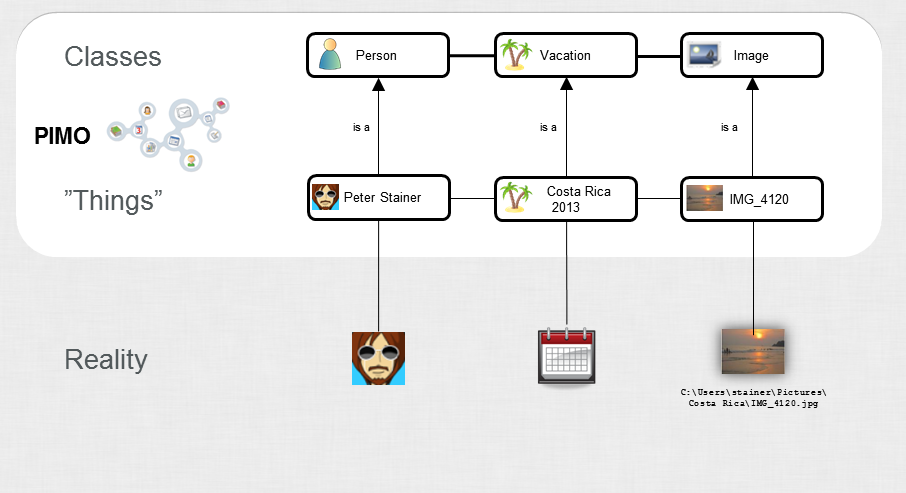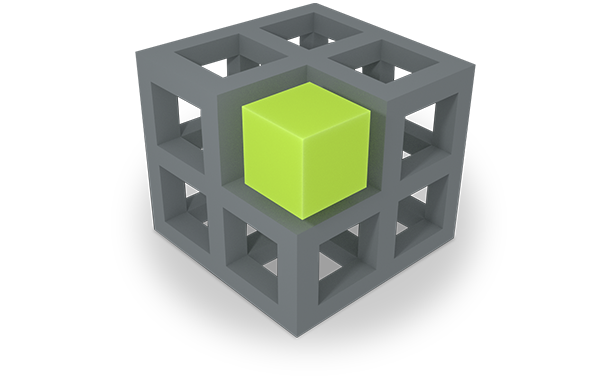In the following, we want to introduce the Semantic Desktop approach and the concept behind the Personal Information Model. The text is based on the introduction from the paper
Heiko Maus, Sven Schwarz and Andreas Dengel:A version of the paper can be found here.
Weaving Personal Knowledge Spaces into Office Applications.
In Madjid Fathi (Ed.): Integration of Practice-Oriented Knowledge Technology: Trends and Prospectives, Springer, 2013, pp. 71-82
Motivation
The Semantic Desktop approach was motivated by the observation that users, especially knowledge workers, would benefit from a support of their personal knowledge management as the modern working environment places high requirements on knowledge workers: they are confronted with various applications, are involved in several projects and processes, work in changing teams, are on the road with a mobile office, and finally, face an ever increasing flow of information. The resulting knowledge spaces are complex, dynamic, distributed over several applications, and use different vocabulary (i.e., set of names for, e.g., folders or tags). In this situation, it is hard to handle the complexity of the resulting personal knowledge space.
Therefore, the approach of the Semantic Desktop addresses this challenge. It follows the strategy to embed the mental model of the knowledge worker in the daily work by means of a Personal Information Model (PIMO). The mental model is the representation of the world in the user's cognitive system as the user understands it. Therefore, the mental model differs btw. users. The user's mental model in the PIMO consists of concepts (called `Things' such as specific topics, projects, persons, tasks, ...), associations between them (persons are member of projects, a task has topic `Semantic Desktop', ...), and finally, associated resources (documents, emails, web pages, pictures, ...).
The PIMO serves as an easy to understand conceptualization of the knowledge worker's mental model, which can be used as a common vocabulary across different applications. Therefore, the PIMO provides the means required for a multi-criterial document classification considering the user's subjective view. The following figure shows an example of a representation of resources in the real world within the PIMO. The person Peter Stainer, his holiday trip as an event in a calendar, and the photo on his computer are resources in the real world.

These resources are represented in the PIMO as things which have different types (in knowledge
representation terms these are instances of classes). The relations between the things can also be
represented, for instance, that Peter attended the event and a photo has been taken on the trip. Which
classes and relations are possible is defined in the PIMO ontology, which is a model of classes, their
hierarchy, and allowed relations between them (as shown in the upper layer of the figure).
The resulting graph connects various resources, e.g., from the file system with items of a calendar
application, with notes written by the user, with web pages about the holiday. The resources
can further be associated with topics, locations, tasks, etc. In various applications, this graph then allows
to find and access resources or things, to annotate, and to relate them.
The PIMO uses the semantic power of the formal representation of the PIMO ontology, thus, introducing a knowledge representation layer on the user’s computer. Besides enabling to annotate and interconnect resources over application borders, further semantic services are possible which make use of the semantic representation of the user’s mental model in the PIMO.
This support for a user's Personal Information Management (resp. Personal Knowledge Management) - across various applications, embracing various resources, and connecting them in the PIMO, providing contextual information for value-added services - lets the Semantic Desktop approach be ideal for supporting the ForgetIT goals:
First, the Personal Preservation Pilot presents an advanced infrastructure for the Semantic Desktop enabling a plug-in architecture for in-situ PIMO access across different applications, thus, providing users one vocabulary for their work, regardless of the application or location (e.g., for tagging emails and files). This architecture allows ubiquitous access by storing PIMO data in the cloud, thus, allowing to apply sharing to group members such as in the office or in a family.
Second, the Personal Preservation Pilot embeds the Semantic Desktop as Active System in the Preserve-or-Forget Framework. By doing this the Semantic Desktop contributes to the ForgetIT goals, namely managed forgetting, contextual remembering, and synergetic preservation as well as takes benefits from this.
